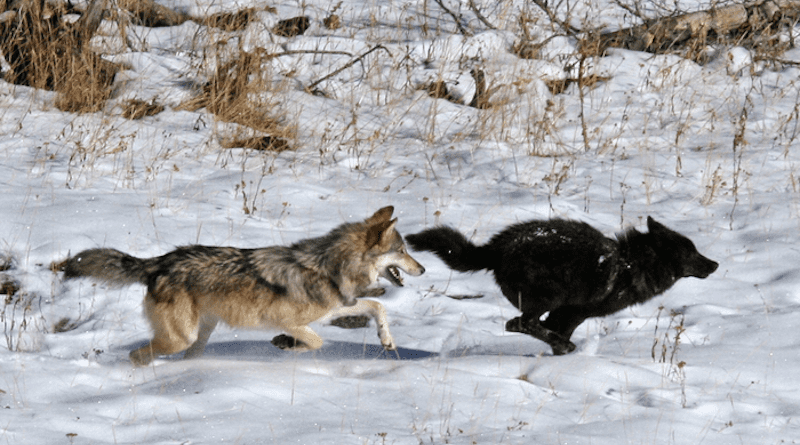Disease Outbreaks Influence Color Of Wolves Across North America
New research from the University of Oxford, Yellowstone National Park, and Penn State, published today in the journal Science, may have finally solved why wolves change colour across the North American continent.
If you were to travel from Arctic Canada and head south down the Rocky Mountains into the US toward Mexico, the further south you go, the more black wolves there are. The reasons why have long puzzled scientists.
Professor Tim Coulson from the Department of Biology, University of Oxford who led the work explains, ‘In most parts of the world black wolves are absent or very rare, yet in North America they are common in some areas and absent in others. Scientists have long wondered why. We now have an explanation based on wolf surveys across North America, and modelling motivated by extraordinary data collected by co-authors who work in Yellowstone.’
Coat colour in wolves (Canis lupus) is determined by a gene called CPD103. Depending on the variant of the gene a wolf has, its coat can either be black or grey.
The researchers postulated that this gene also plays a role in protecting against respiratory diseases such as canine distemper virus (CDV). This is because the DNA region containing the gene also encodes for a protein that plays a role in defending against infections in the lungs of mammals. They predicted that having a black coat would be associated with the ability of wolves to survive an infection with CDV.
To test this idea, they analysed 12 wolf populations from North America, to examine whether the probability of a wolf being black was predicted by the presence of CDV antibodies. If a wolf has CDV antibodies, then it has caught CDV in the past and survived. They found that wolves with CDV antibodies were more likely to be black than grey. They also found that black wolves were more common in areas where CDV outbreaks occurred.
The researchers analysed over 20 years-worth of data from the wolf population at Yellowstone National Park. They found that black wolves were more likely to survive CDV outbreaks compared with grey wolves. These results led them to hypothesise that in areas where distemper outbreaks occur wolves should choose mates of the opposite coat colour to maximize the chance their cubs would have black coats.
They used a simple mathematical model to test this idea. Excitingly, the predictions from their model closely matched the observations that black and grey wolves were more likely to pair in areas where CDV outbreaks are common. This competitive advantage is lost in areas where CDV outbreaks do not occur.
These results are consistent with the idea that the frequency of CDV outbreaks across North America is responsible for the distribution of black wolves, because having the gene for a black coat may also provide protection against the virus. It also explains why mating pairs in Yellowstone, where canine distemper outbreaks occur, tend to be black-grey.
Peter Hudson, Willaman Professor of Biology, Penn State said ‘It’s intriguing that the gene for protection against CDV came from domestic dogs brought by the first humans entering North America, and the CDV disease virus emerged in North America many thousands of years later, once again from dogs.’
‘What I love about this study is how we have been able to bring together experts from so many fields and a range of approaches to show how disease can have remarkable impacts on wolf morphology and behaviour. We are learning that disease is a major evolutionary driver that impacts so many aspect aspects of animal populations.’
The researchers speculate that other species may follow a similar pattern to wolves. Many insects, amphibians, birds and nonhuman mammals have associations between colour and disease resistance. It might be that the presence a disease, or how frequently a disease outbreak occurs, is an important factor affecting the colour of mate an animal prefers.


Scientists, including both wildlife biologists and wildlife ecologists, have collected so much fascinating information about wolves and other wildlife in Yellowstone National Park. This park is really a treasure to protect, as are the animals that call this park “home”. It is too bad the people in the adjacent states and the people who manage our US Forest Service cannot understand this. Also interesting about this study is the importance of individual differences in members within wildlife populations and how these differences can lead to changes that help a species survive in the face of new challenges, such as new diseases. Most of our state wildlife managers are still managing at the “population” level and are ignoring the importance of individual differences. When will our state wildlife managers begin to use the newest and best science? What is being taught at the university level in wildlife biology and ecology where these “wildlife managers” earn their degrees? It is fascinating to read about research like this. My state’s department of wildlife is actually still the old department of “game” . Only the name was changed. It is still focused on raising as many elk and deer as possible on our public lands to keep the hunters happy.